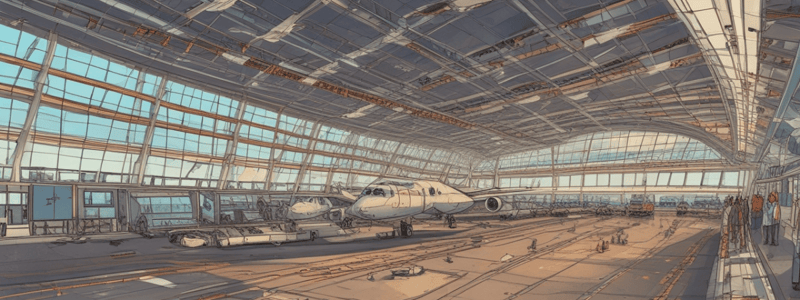Podcast
Questions and Answers
What is the primary purpose of EMAS technology?
What is the primary purpose of EMAS technology?
- To reduce aircraft weight
- To extend the runway length
- To prevent runway overruns (correct)
- To improve taxi operations
What is the material used in the construction of EMAS?
What is the material used in the construction of EMAS?
- Rubberized asphalt
- Heavy steel plates
- Carbon fiber mesh
- Lightweight, crushable concrete blocks (correct)
What happens when an aircraft enters an EMAS?
What happens when an aircraft enters an EMAS?
- The aircraft is alerted to abort the landing
- The aircraft is directed to a parallel runway
- The weight of the aircraft crushes the material in a controlled manner (correct)
- The aircraft is lifted off the ground
What is the main consideration for pilots when taxiing on EMAS-equipped runways?
What is the main consideration for pilots when taxiing on EMAS-equipped runways?
What is the benefit of having an EMAS installation at an airport?
What is the benefit of having an EMAS installation at an airport?
Why is EMAS not a substitute for a proper runway length?
Why is EMAS not a substitute for a proper runway length?
What is the primary benefit of EMAS in terms of aircraft safety?
What is the primary benefit of EMAS in terms of aircraft safety?
What is the purpose of the arrestor beds in EMAS?
What is the purpose of the arrestor beds in EMAS?
What happens to the aircraft when it enters the EMAS?
What happens to the aircraft when it enters the EMAS?
Why is EMAS installed at the end of runways?
Why is EMAS installed at the end of runways?
EMAS technology is primarily designed to mitigate the impact of a bird strike during takeoff.
EMAS technology is primarily designed to mitigate the impact of a bird strike during takeoff.
The arrestor beds in EMAS are made of a highly durable, non-crushable material.
The arrestor beds in EMAS are made of a highly durable, non-crushable material.
The weight of the aircraft crushes the arrestor beds, causing a significant reduction in the aircraft's speed.
The weight of the aircraft crushes the arrestor beds, causing a significant reduction in the aircraft's speed.
EMAS is specifically designed to stop aircraft without any damage to the aircraft's structure.
EMAS is specifically designed to stop aircraft without any damage to the aircraft's structure.
Pilots are required to maintain a specific taxiing speed when crossing EMAS areas.
Pilots are required to maintain a specific taxiing speed when crossing EMAS areas.
EMAS installation is a mandatory requirement at all airports, regardless of runway length.
EMAS installation is a mandatory requirement at all airports, regardless of runway length.
The primary purpose of EMAS is to provide an additional safety margin in case of a runway overrun.
The primary purpose of EMAS is to provide an additional safety margin in case of a runway overrun.
The design of EMAS ensures that the aircraft comes to a complete stop within a short distance, without the need for braking.
The design of EMAS ensures that the aircraft comes to a complete stop within a short distance, without the need for braking.
The effectiveness of EMAS is primarily determined by the weight of the aircraft and its speed upon entering the system.
The effectiveness of EMAS is primarily determined by the weight of the aircraft and its speed upon entering the system.
The presence of EMAS can completely eliminate the risk of runway overruns.
The presence of EMAS can completely eliminate the risk of runway overruns.
Explain how the design of EMAS contributes to pilot safety during runway overruns.
Explain how the design of EMAS contributes to pilot safety during runway overruns.
Discuss the implications of EMAS on airport runway design and infrastructure limitations.
Discuss the implications of EMAS on airport runway design and infrastructure limitations.
Why is it essential for pilots to be aware of EMAS regions during taxi operations?
Why is it essential for pilots to be aware of EMAS regions during taxi operations?
What role does the crushable material play in the effectiveness of EMAS during an aircraft overrun?
What role does the crushable material play in the effectiveness of EMAS during an aircraft overrun?
Evaluate the statement: EMAS technology can replace the need for longer runways.
Evaluate the statement: EMAS technology can replace the need for longer runways.
How does the weight of the aircraft affect its interaction with EMAS?
How does the weight of the aircraft affect its interaction with EMAS?
What are the risks if pilots do not follow taxiing procedures around EMAS?
What are the risks if pilots do not follow taxiing procedures around EMAS?
Analyze the potential consequences of not having EMAS installations at critical airports.
Analyze the potential consequences of not having EMAS installations at critical airports.
In what way does EMAS technology embody the phrase 'keeping your ambitions sky-high' in aviation safety?
In what way does EMAS technology embody the phrase 'keeping your ambitions sky-high' in aviation safety?
Describe how EMAS technology improves the overall safety protocols at an airport.
Describe how EMAS technology improves the overall safety protocols at an airport.
Study Notes
Engineered Material Arresting System (EMAS) Overview
- EMAS is a crucial safety feature designed to prevent runway overruns, which can lead to serious accidents.
- It consists of a bed of engineered materials located at the end of runways, designed to decelerate aircraft in emergencies.
Design and Functionality of EMAS
- Constructed from crushable materials, EMAS absorbs the energy of an overrunning aircraft, allowing for safer deceleration.
- The design allows it to support airport vehicles while crushing under heavier aircraft weight, effectively stopping them.
Importance of EMAS
- Reduces risks of aircraft damage and passenger injury during runway overruns, especially at airports with space constraints.
- Unlike traditional safety areas that require extensive land, EMAS can be installed in limited spaces, making it adaptable to urban or environmentally sensitive locations.
Benefits of EMAS
- Increases safety margins and supports the operation of large aircraft without necessitating runway length extensions.
- Proven effectiveness, with real-world instances showcasing successful emergency stops without casualties or significant damage.
- Provides long-term cost savings due to reduced aircraft damage and liability, as well as enhanced safety for airport operations.
Maintenance and Regulatory Considerations
- Regular inspections and timely repairs are essential after an aircraft makes an arrestment to keep EMAS operational.
- Must adhere to FAA regulations and guidelines for design, construction, and maintenance to ensure safety standards across airports.
Environmental Considerations
- EMAS materials are typically recyclable or reusable, reflecting a commitment to sustainability within aviation safety practices.
Future Developments
- Ongoing technological innovations aim to improve EMAS effectiveness, installation processes, and overall robustness for better performance during emergencies.
Overall Significance
- EMAS exemplifies modern aviation safety solutions and highlights the industry's commitment to protecting lives and reducing risk during critical flight operations.
Engineered Material Arresting System (EMAS) Overview
- EMAS is a crucial safety feature designed to prevent runway overruns, which can lead to serious accidents.
- It consists of a bed of engineered materials located at the end of runways, designed to decelerate aircraft in emergencies.
Design and Functionality of EMAS
- Constructed from crushable materials, EMAS absorbs the energy of an overrunning aircraft, allowing for safer deceleration.
- The design allows it to support airport vehicles while crushing under heavier aircraft weight, effectively stopping them.
Importance of EMAS
- Reduces risks of aircraft damage and passenger injury during runway overruns, especially at airports with space constraints.
- Unlike traditional safety areas that require extensive land, EMAS can be installed in limited spaces, making it adaptable to urban or environmentally sensitive locations.
Benefits of EMAS
- Increases safety margins and supports the operation of large aircraft without necessitating runway length extensions.
- Proven effectiveness, with real-world instances showcasing successful emergency stops without casualties or significant damage.
- Provides long-term cost savings due to reduced aircraft damage and liability, as well as enhanced safety for airport operations.
Maintenance and Regulatory Considerations
- Regular inspections and timely repairs are essential after an aircraft makes an arrestment to keep EMAS operational.
- Must adhere to FAA regulations and guidelines for design, construction, and maintenance to ensure safety standards across airports.
Environmental Considerations
- EMAS materials are typically recyclable or reusable, reflecting a commitment to sustainability within aviation safety practices.
Future Developments
- Ongoing technological innovations aim to improve EMAS effectiveness, installation processes, and overall robustness for better performance during emergencies.
Overall Significance
- EMAS exemplifies modern aviation safety solutions and highlights the industry's commitment to protecting lives and reducing risk during critical flight operations.
Engineered Material Arresting System (EMAS) Overview
- EMAS is a crucial safety feature designed to prevent runway overruns, which can lead to serious accidents.
- It consists of a bed of engineered materials located at the end of runways, designed to decelerate aircraft in emergencies.
Design and Functionality of EMAS
- Constructed from crushable materials, EMAS absorbs the energy of an overrunning aircraft, allowing for safer deceleration.
- The design allows it to support airport vehicles while crushing under heavier aircraft weight, effectively stopping them.
Importance of EMAS
- Reduces risks of aircraft damage and passenger injury during runway overruns, especially at airports with space constraints.
- Unlike traditional safety areas that require extensive land, EMAS can be installed in limited spaces, making it adaptable to urban or environmentally sensitive locations.
Benefits of EMAS
- Increases safety margins and supports the operation of large aircraft without necessitating runway length extensions.
- Proven effectiveness, with real-world instances showcasing successful emergency stops without casualties or significant damage.
- Provides long-term cost savings due to reduced aircraft damage and liability, as well as enhanced safety for airport operations.
Maintenance and Regulatory Considerations
- Regular inspections and timely repairs are essential after an aircraft makes an arrestment to keep EMAS operational.
- Must adhere to FAA regulations and guidelines for design, construction, and maintenance to ensure safety standards across airports.
Environmental Considerations
- EMAS materials are typically recyclable or reusable, reflecting a commitment to sustainability within aviation safety practices.
Future Developments
- Ongoing technological innovations aim to improve EMAS effectiveness, installation processes, and overall robustness for better performance during emergencies.
Overall Significance
- EMAS exemplifies modern aviation safety solutions and highlights the industry's commitment to protecting lives and reducing risk during critical flight operations.
Studying That Suits You
Use AI to generate personalized quizzes and flashcards to suit your learning preferences.
Related Documents
Description
Learn about the Engineered Material Arresting System (EMAS), a critical component of airport safety, and its role in preventing runway overruns and accidents.




